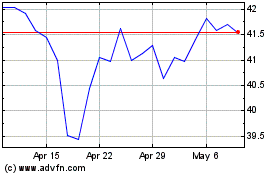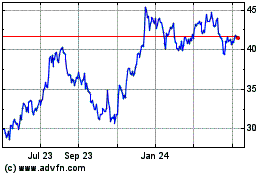By AnnaMaria Andriotis
Federal programs designed to ease the burden of college loans
are causing snarls in the bond market and raising concerns that
banks may soon ratchet back lending.
The programs, which let struggling borrowers scale back their
repayments, have made student loans more affordable at a time when
millions of Americans are falling behind on their student
debts.
But that slowing stream of money is having a knock-on effect in
the market for bonds backed by that debt. Investors who own the
bonds are beginning to worry that they may not get repaid on time,
and they are balking at buying new bonds being offered by financial
institutions.
Without that revenue from selling off the student loans into
bonds, banks have less capital to turn into new loans.
Credit rating firms Moody's Investors Service Inc. and Fitch
Ratings Inc. have collectively placed more than $36 billion worth
of bonds backed by student loans on watch for a possible downgrade,
warning it is increasingly likely that borrowers won't pay their
loans off in full by their original due dates and that bonds backed
by those loans could end up in default.
The result is that investors are demanding better prices in the
esoteric but crucial market where banks raise capital by selling or
repackaging their loans.
Last week, U.S. Bancorp said it dropped an effort to sell a $3
billion portfolio of student loans because the bids were too low.
It has said it plans to take a write-down of $55 million to $60
million, reflecting the diminished value of those assets.
An inability to sell the federal loans, whether to other
companies or by turning them into bonds, will make it harder for
banks to increase their loan volumes.
U.S. Bancorp wouldn't comment on what it would have done with
the proceeds of the loan sale, but banks generally sell student
loan portfolios to raise cash so they can make new student loans or
other consumer loans, said Mark Kantrowitz, senior vice president
at Edvisors.com, which tracks the student loan market.
Loan originations could also be hurt if banks take a loss on
sales, he said. There could be "a lot of contagion effects," he
said. "The disruption of the capital markets may prevent some
consumers from getting loans if the uncertainty persists for too
much longer."
The Education Department didn't have immediate comment Wednesday
but in recent weeks has said that income-based repayment is
designed as a safety net for borrowers in tough times. Education
Secretary Arne Duncan said in August that the programs have helped
reduce the rate of short-term delinquencies for student loans.
"We've made it a priority to give Americans better options to
manage their student loans and make sure they know about those
options," Mr. Duncan said at the time.
Meanwhile, just one $203 million deal to repackage the affected
loans has gone through since late June, when Moody's warned of a
downgrade for the bulk of the more than $36 billion in bonds. That
compares with 13 deals totaling $4 billion in the same period last
year, according to Moody's.
Some analysts say this part of the securitization market could
stay frozen until Moody's finishes its review, possibly having
ripple effects into the ability of banks to increase new loan
originations to students and other consumers.
Moody's is expected to make a decision on whether to downgrade
the bonds as early as November. "It's very difficult to predict
cash flows on these loans because of the different payment programs
that have come up, " said Debash Chatterjee, managing director of
asset-backed securities surveillance at Moody's.
The loans under pressure are federal student loans made by
private lenders under the Federal Family Education Loan Program, or
FFELP.
The federal government brought the program to an end in 2010 by
moving all federal student loan origination to the Education
Department, but many firms still hold the old loans on their books
and have continued to securitize or sell some of them to free up
their balance sheets for new loans.
As of June, there were $371 billion of FFELP loans outstanding,
according to the Education Department. Overall, there are $1.27
trillion of outstanding student loans, 93% of which are federally
backed, according to MeasureOne, a San Francisco-based firm that
tracks the student loan market.
FFELP loans account for nearly one-third of all federal student
loans, based on Education Department data.
U.S. Bancorp stopped making new student loan originations in
2012, but continues to own FFELP student loans and was seeking to
free up capital for other purposes in its recent sales effort. "The
market broke," U.S. Bancorp Chief Executive Richard Davis said at
an investor conference last week. He said bids "came in at very,
very low levels."
The main income-based repayment program for FFELP borrowers
became available in 2009, shrinking their monthly payments to 15%
of their discretionary income over a payment period of 25 years.
But the push to get borrowers into the program accelerated in 2013,
when the Education Department reached out to more than three
million federal-student loan borrowers to inform them about
availability, according to an August 2015 report from the
Government Accountability Office.
Many of the loans in question are held by Navient Corp., the
largest U.S. servicer of student loans. Navient, which last year
spun off from SLM Corp.--Sallie Mae--has securitized 84% of its
roughly $100 billion in FFELP loans, which frees it up to buy more
loans from lenders.
Moody's has put $34 billion of these bonds on watch for a
downgrade this year through June. Since then, Navient's shares have
tumbled about 35%.
Navient was the largest buyer of FFELP student loans last year,
purchasing $11.3 billion of these loans from banks and other
institutions, according to the company. Wells Fargo & Co., the
second-largest private student loan originator by volume, sold $8.5
billion of FFELP loans to Navient late last year.
The company says it can withstand a long freeze in the
securitization market.
"There is some confusion here that if Moody's downgrades, that
the company won't be able to issue securitizations and won't be
able to meet debt obligations--my point is we have ample liquidity
to do that without needing to access the market," said Jack
Remondi, chief executive of Navient, in an interview.
Student loans and other parts of the bond market froze during
the recession, but this is the first time the FFELP market has been
singled out for the risk of widespread problems on securitized
bonds, said Mark Adelson, a New York-based securitization
expert.
The risk isn't one of ultimate losses for investors but rather
delays in payment that go past the maturity date of the bond. "It's
conceivable it could be a long time," he said.
J.P. Morgan Chase & Co. had more than $4.5 billion of the
federal student loans on its books as of June, according to bank
filings, with some $500 million in delinquency or default. A bank
spokeswoman said it has no plans to sell these loans at this time.
SunTrust Banks held $4.4 billion of these loans as of June. A bank
spokesman declined to comment on future plans for its loan
holdings.
Write to AnnaMaria Andriotis at annamaria.andriotis@wsj.com
Subscribe to WSJ: http://online.wsj.com?mod=djnwires
(END) Dow Jones Newswires
September 23, 2015 20:23 ET (00:23 GMT)
Copyright (c) 2015 Dow Jones & Company, Inc.
US Bancorp (NYSE:USB)
Historical Stock Chart
From Mar 2024 to Apr 2024

US Bancorp (NYSE:USB)
Historical Stock Chart
From Apr 2023 to Apr 2024
